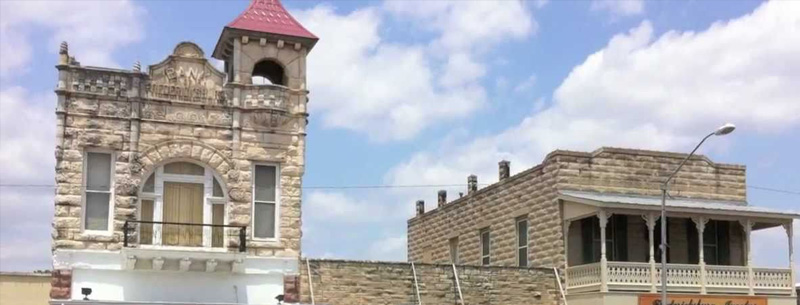It seems strange to find a German-influenced town in the middle of Texas Hill Country. However, in the aftermath of the Revolution of 1848 (or the March Revolution) that resulted in the splintering of the Austrian Empire, liberal and educated Germans fled their nation in droves. Some even renounced their titles and status in order to forge new lives. One such man was Baron von Meusebach, who led immigrants to Texas.
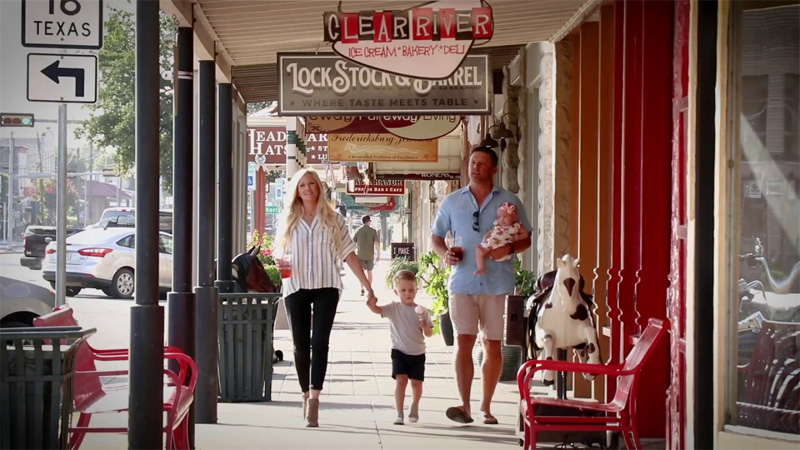
Fredericksburg was formed in 1842 by the Adelsverein (German Emigration Company), as a series of settlements in central Texas. John Meusebach (the former Baron) named the town after the Prince of Prussia. It was laid out in a similar way to the German villages located along the Rhine, with settlers receiving ten acres of farmland and a small town lot. Within two years of being established, the town blossomed to one thousand residents.
This boom was helped by the opening of a road to Austin, a peace treaty with the native tribes, the establishment of Fredericksburg as the county seat, and the construction of Fort Martin Scott. The fort was active from 1848-1853 and its primary use was during the Mexican-American War. Many of the structures that we will be highlighting come from this era.
National Museum of the Pacific War
Before you begin the walking tour, take an hour or so to visit the National Museum of the Pacific War at 340 East Main Street. The museum focuses on the U.S. involvement in the Pacific during WWII and preserves the legacy of Fleet Admiral – and hometown boy – Chester Nimitz. Nimitz is the reason that Americans are not speaking Japanese.
Immediately following Pearl Harbor, Nimitz was appointed as Commander-in-Chief of the U.S. Pacific Fleet. He planned many major operations, including Iwo Jima and Okinawa, which turned the tide of the war. He was also instrumental in the defeat of the Japanese and was present to accept their surrender in September 1945.
I think that what followed indicates the importance of Nimitz’s role during WWII: there was a ‘Nimitz Day’ in his honor, he was awarded medals by thirteen countries (not including the United States) a supercarrier was named for him, along with countless schools and roadways, and even a glacier in Antarctica. Yes, he was that big a deal.
Head northeast along Main Street
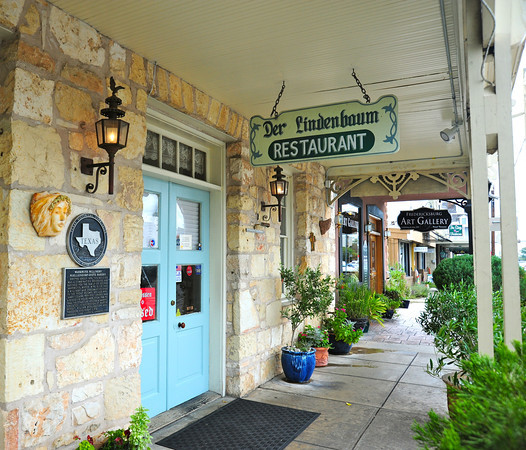
Wahrmund Millinery/Moellendorf-Dietz Bakery
Wahrmund Millinery/Moellendorf-Dietz Bakery at 312 East Main Street. Built in 1876, this building housed Elise Wahrmund’s millinery: it was located on the ground floor, while the family lived above. For a brief time it was a boarding house, before the Moellendorf-Dietz bakery took it over, from 1924-1966.
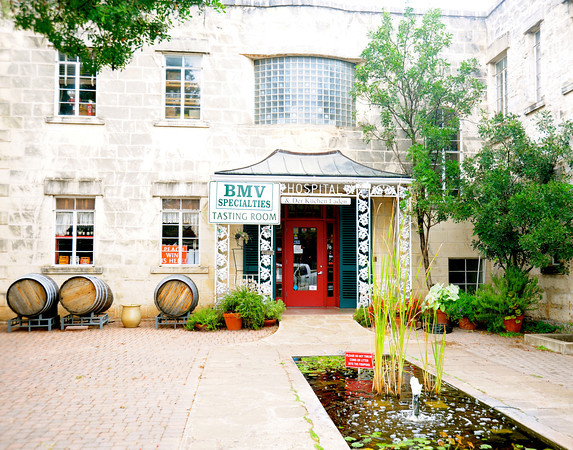
Keidel Memorial Hospital
Keidel Memorial Hospital at 254-258 East Main Street. In 1909, Dr. Albert Keidel had this hospital built to honor his father, Dr. Wilhelm Victor Keidel. The senior Keidel was the county’s first doctor, he served as a judge and also founded the neighboring town of Pedernales. The hospital remained in service until 1971.
Domino Parlor
Domino Parlor: 222 East Main Street. Look for the walls of the original stone building from the 1850s. The structure has been added onto several times over the decades. The small, original home was built by the pioneer settler John Schmidtzinsky. However, over the years, it has hosted pharmacy, jewelry, and musical instrument stores – concerts were held in the front room.
Palace Theatre
Palace Theatre: 146 East Main Street. This one-time theatre showed movies from 1922-2000 before it was completely remodeled and converted into a western wear store.
Bank of Fredericksburg
Bank of Fredericksburg: 120 East Main Street. This Richardsonian Romanesque style building dates back to 1889 and was one of many buildings designed by Alfred Giles.
English-born Giles wanted to pursue a career in ministry, but he was apprenticed to an architectural firm in London during his late teens. He attended classes at King’s College before emigrating to the U.S. For health reasons, he settled in San Antonio, where he joined the firm of a contractor. He opened his own office in 1876.
Giles’ approach took former architectural styles, combined them and simplified their design. At his peak, he was commissioned to work on many mansions in the King William Historic District in San Antonio, a hall, offices for Incarnate Word College in Fredericksburg, three county courthouses, and the Bandera County Jail.
As fewer commissions came in, Giles moved to Monterrey, Mexico. After that, he became a successful rancher near Comfort, Texas. He was a founding member of the Texas Sheep and Goat Raiser’s Association. He passed away on August 13, 1920, and is buried on his ranch – Hillingdon.
Vereins Kirche
Vereins Kirche: Markplatz on East Main. Friedrich Schubert designed the People’s Church, which was built in 1847. The design was based on the Cathedral at Aachen and was in the Carolingian style. The church is an octagon, with each wall measuring 18×18 feet, mounted by a cupola. It originally held, not a cross, but a rooster shaped weather vane! This church was non-denominational, hosting services for all religions until each splintered off to build their own church. The first were the Catholics, who raised funds to build Old St. Mary’s in 1848. (We’ll see this church later).
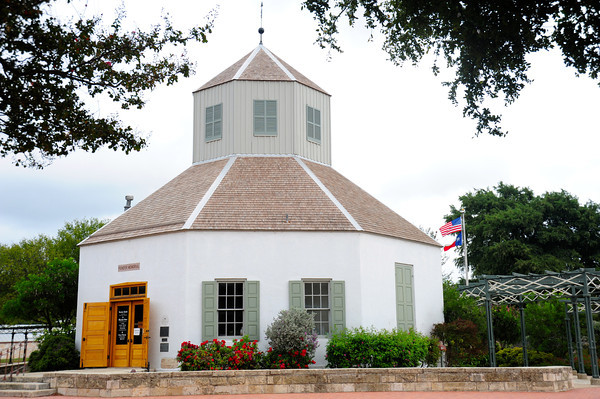
The structure was also used as a town hall, fort, and school. The students were taught in German and their parents funded the school with a $1 tuition fee, paid each quarter. The church currently contains a local history collection, and this is where I met Bud – who turns ninety next month.
He explained that the building that we were standing in is an exact replica of the original church – minus one door that became a window – and it was only three hundred yards north of its original location. The cows kept running down Main Street and taking over the church grounds. Being Texas, the church was moved rather than the cows.
The church originally had two doors. The men entered the south door and sat on the right side of the aisle, while the women entered the north door and were seated on the left.
“When I was young they still taught in German,” Bud told me. “So when [WW]II started all the young men in town joined up. We all spoke German and thought we’d help.” He paused, “But, the sense that the government got, we were all sent to the Pacific, every last one of us.”
After the Markplatz, Main Street becomes West Main.
7) For a good lunch, walk to Hondo’s at 312 West Main. Try their grilled Mahi Mahi sandwich – messy but tasty. It is served on Texas toast, topped with onion, lettuce and tomato. The dish comes with two sauces – lime/jalapeno vinaigrette or avocado sauce, which is guacamole’s smoother, fancier cousin. It’ll set you back $9. If you’re lucky, you can enjoy music on the indoor stage, the scent of the pit BBQ, and the relaxed patio. As a bonus, there is a very full bar and it’s dog friendly.
Cross the street to the Museum Complex
Pioneer Museum Grounds
Pioneer Museum Grounds: 325 West Main Street. There are a number of buildings located on the property, including several homes, a bathhouse, fire department and school. Many of the structures have been moved from other nearby counties. There are two structures of note:
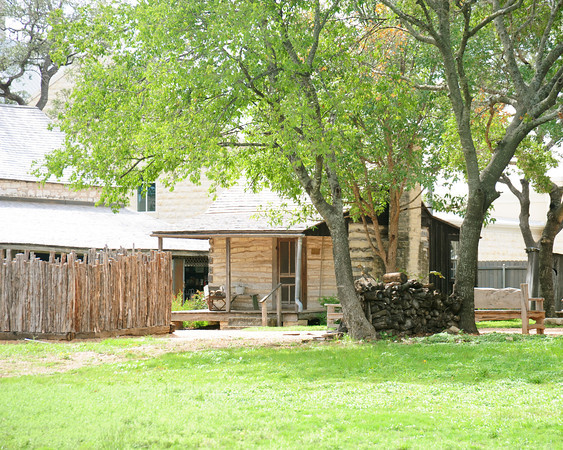
Weber Sunday House
The Weber family built the Weber Sunday House in 1904. It lacked both electricity and running water. It’s a one-room up, one room down structure, with a small porch. There is a lean-to kitchen in the rear.
These townhomes became popular in the 1880s and are unique to the area. The family also owned a large farm seven miles from town. They left their home on Saturday morning, ran errands in town and socialized, before attending church and heading home on Sunday. The houses were also occupied when a family needed medical attention, or the farmer/rancher retired, leaving the large home to sons.
Sunday homes can also be found in Middlebury Connecticut and in Pennsylvania Dutch Country, as this type of building was the custom in several European countries. The homes decreased in popularity in the 1920s, as roads began to be maintained and cars grew more common.
Around the corner, at Orange & West San Antonio is:

Old St. Mary’s Church
Old St. Mary’s Church at 306 West San Antonio. In 1848, after splintering from the Vereins Kirche, the Catholics of the area constructed a log cabin on the site. A little over a decade later, a popular missionary stopped in Fredericksburg to offer mass and give several sermons. He stated he would return only if the town built a proper church. Construction began within a year.
A second and larger Gothic church was constructed nearby in 1906. It is one of fifteen ‘painted churches’ spread throughout the Hill Country. The simple exteriors mask the brightly painted murals of the interior. Most of these murals are in German (or Czech) and people are not allowed to photograph the interior. Also located on the property, is the Our Lady of Guadalupe Chapel, built in 1919 for the Spanish-speaking community.
Double back to Main Street.
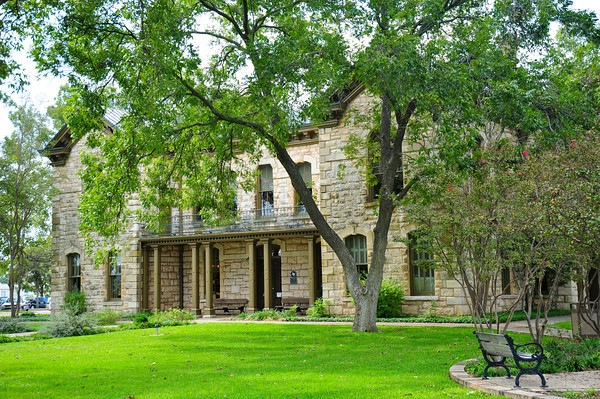
Fredericksburg Memorial Library
Fredericksburg Memorial Library at 115 West Main Street. This structure was designed by Alfred Giles (remember him from above?) and built in 1882, as the second courthouse for the town. It was used as such until 1939, when the third, and current, the courthouse was constructed.
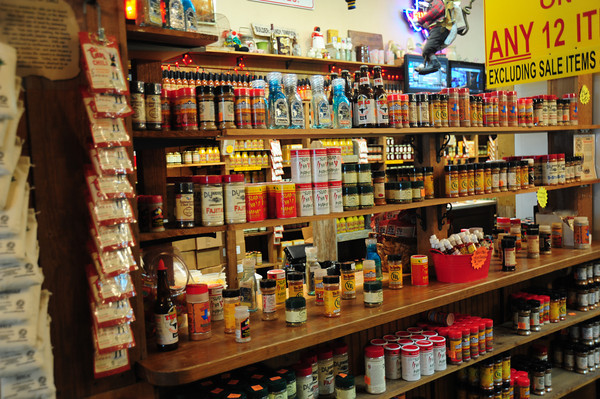
Rustlin’ Robs
Rustlin’ Robs at 121 East Main Street. OK, it’s not historic, but I had to point out this place. It sells just about every sauce, dressing, mix or rub from the Hill Country. Spend some time burning off your taste buds (otherwise known as sampling the hot sauces).
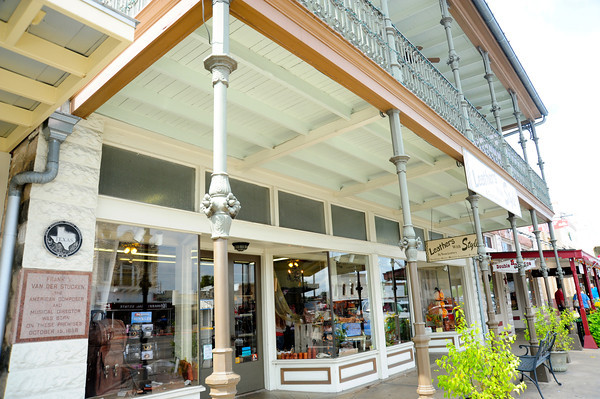
Frank van der Stucken Birthplace
Frank van der Stucken Birthplace at 121 East Main Street (part of a shopping complex). Frank van der Stucken studied at a music conservatory in Belgium, before touring Germany under the tutelage of Liszt. Upon his return to the States, he became the leader of the Arion Society. He also performed at the Paris Expo and gave concerts throughout Europe. In 1895, he became the dean of Cincinnati’s College of Music and conducted the city’s symphony. He died at the age of seventy, in Germany.
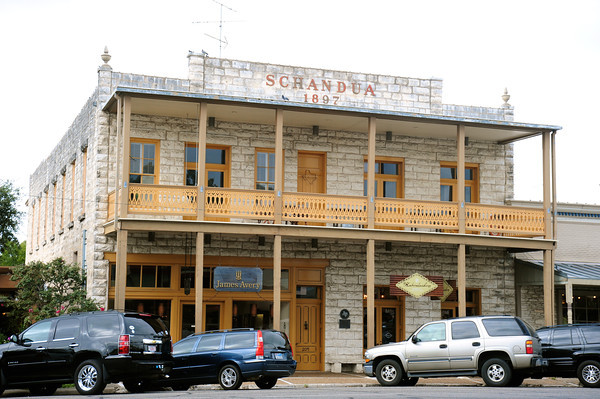
Schandua
Schandua at 205 East Main Street. This limestone building was constructed in 1897 for the Schandua family, on an original town plot. The ground floor served as a hardware store until 1972 and the family lived on the second floor.
